Invasive plants are a common topic in gardening circles, and they can cause lots of problems for the backyard gardener and the environment. Sometimes invasive plants can find their way into your garden by natural means, but some invasive plants are still available for purchase at plant nurseries, and unsuspecting gardeners may plant invasives, not knowing the damage they can do. This can result in difficult plants that can rapidly overrun your garden, spread in the wild, and cause other issues too.
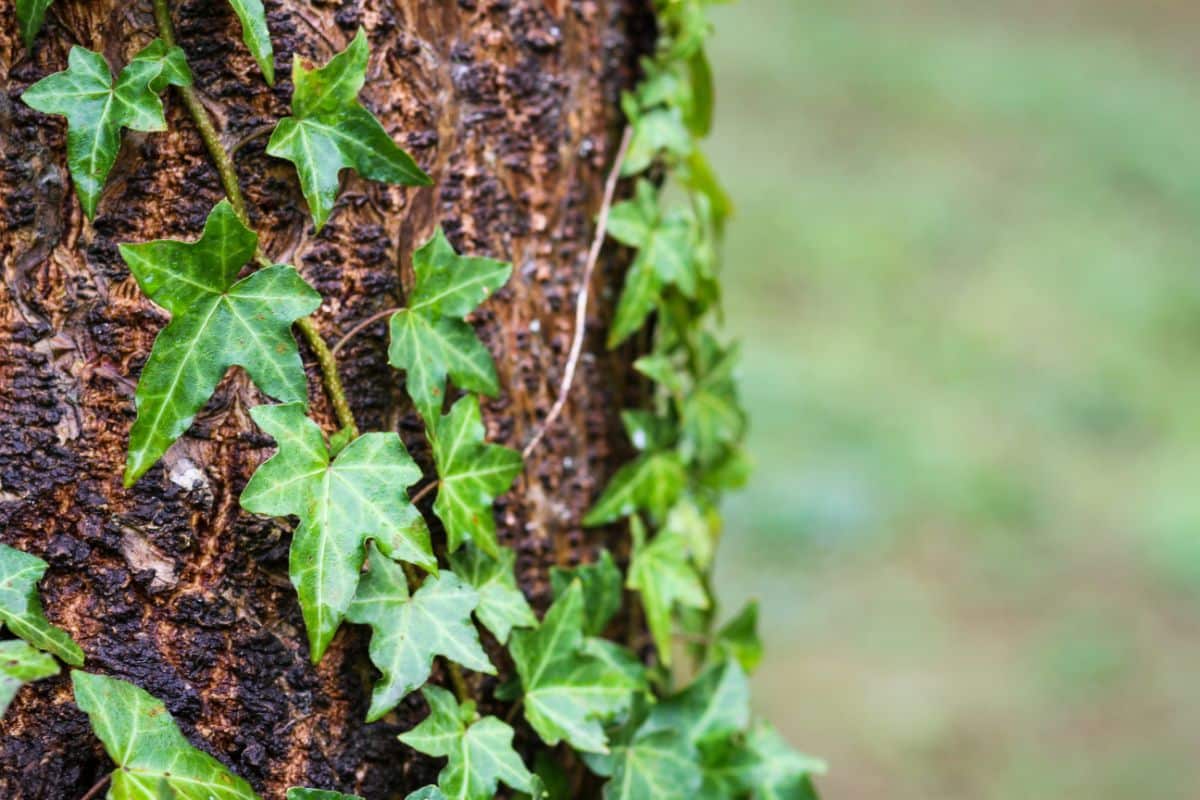
While there are many different invasive plants that you should be aware of, in the list below, you’ll find 12 of the most common and destructive invasive plants around. Some of these plants have become so notorious that they aren’t sold in stores today, although they were once intentionally planted by gardeners. Other invasive plants on this list are still available for sale, but they can be so troublesome it’s best to avoid them.
To learn more about invasive plants and what to do about them, read on!
Jump to:
- What are invasive plants?
- 12 common invasive plants to avoid in your garden
- 1. Oriental bittersweet (Celastrus orbiculatus)
- 2. Japanese knotweed (Reynoutria japonica)
- 3. Kudzu (Pueraria montana)
- 4. Barberry (Berberis spp.)
- 5. English ivy (Hedera helix)
- 6. Multiflora rose (Rosa multiflora)
- 7. Japanese honeysuckle (Lonicera japonica)
- 8. Bamboo (Phyllostachys spp.)
- 9. Norway maple (Acer platanoides)
- 10. Burning bush (Euonymus alatus)
- 11. Garlic mustard (Alliaria petiolata)
- 12. Wintercreeper (Euonymus fortunei)
- Removing invasive plants without chemicals
- Summary
What are invasive plants?

Invasive plants are non-native species that have been transported to new environments. But unlike native plant species that support the ecosystem and native animals, invasive plants can cause a lot of problems for the environment, wildlife, and people too. Many invasive plants were intentionally planted by people for ornamental and other purposes, but they are difficult to control and easily spread beyond backyards and cultivated gardens.
Invasive plants are less useful for pollination and native wildlife, but they cause other problems too. Many invasive plants grow faster and more aggressively than native species, and they can outcompete and smother native plants, decreasing biodiversity, endangering species, and reshaping entire landscapes. Some invasive plants can also release compounds into the soil that suppress the growth of other plants, or they can cause rashes to the skin or even damage property with their vigorous roots.
Plus, invasive plants are very good at self-sowing, and their seeds are often spread by wildlife, or they can be tracked around on people’s shoes! Once they invade, invasives can be extremely difficult to eradicate due to their abundance of seeds, tough root systems, and other factors.
12 common invasive plants to avoid in your garden
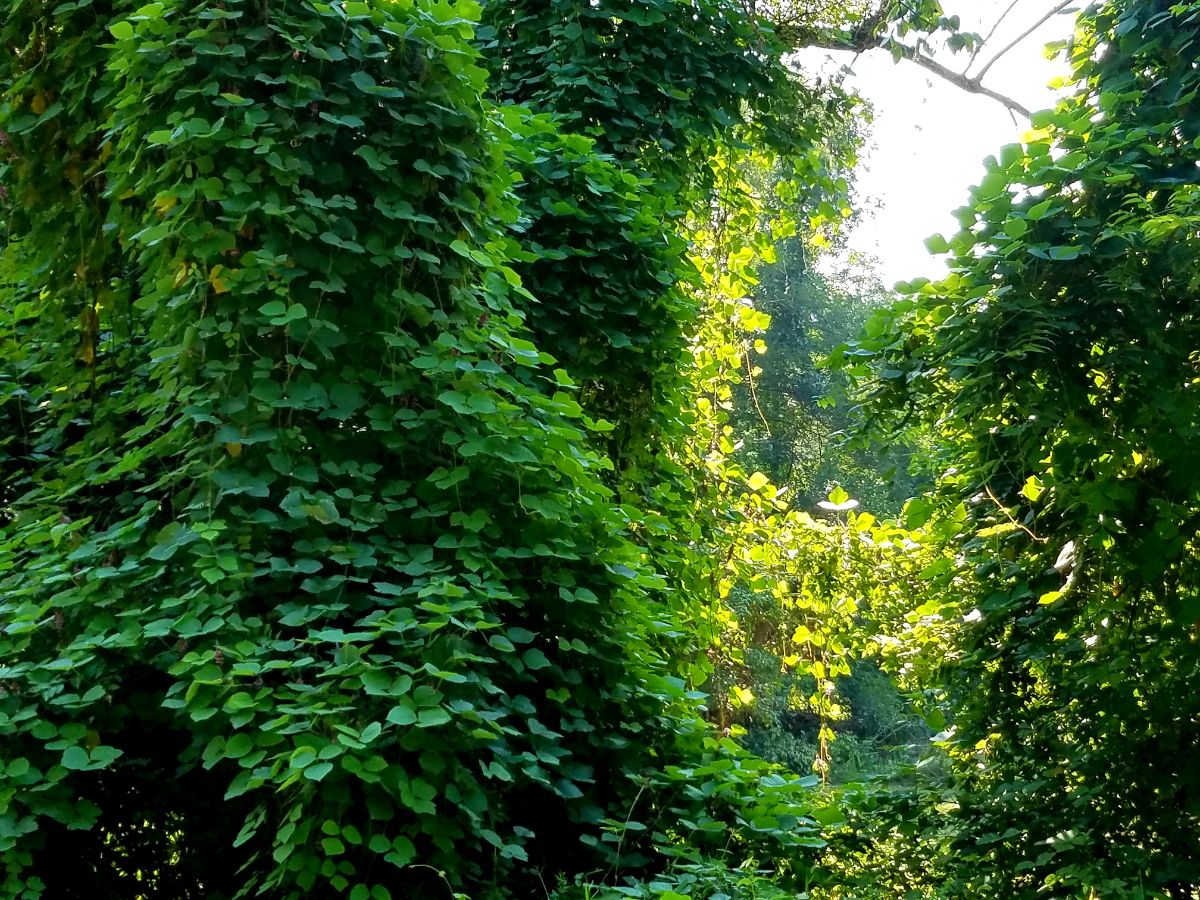
Invasive plants find their way into gardens and the environment by many different means. Sometimes these plants spread on their own, or their seeds can be dispersed by birds and wildlife. Unfortunately, many invasive species are still being sold at garden centers, but these pesky plants can cause devastating impacts on the environment, and they can wreak havoc in your garden too!
1. Oriental bittersweet (Celastrus orbiculatus)

Oriental bittersweet is one of the most noxious invasive plants around, and it can cause a lot of property damage, not to mention it decreases biodiversity and harms native plants. Bittersweet was first introduced into America in the 1860s, and it was prized as an ornamental for its colorful autumn berries. But these plants quickly escaped into the wild and have been causing trouble ever since!

Bittersweet is a vining plant that can twine its way around trees and shrubs and girdle them. Bittersweet vines are even so vigorous they can crawl all the way up trees and pull them down! Plus, these plants spread very quickly because their berries are often eaten by birds, and they are also dispersed by well-meaning crafters who often gather bittersweet for wreath making.
But before you start pulling bittersweet out of your garden, make sure that the plant you have is actually oriental bittersweet. There is also an American bittersweet that is native to the United States, and this plant is on the decline because it is often outcompeted by the non-native oriental bittersweet vine.
2. Japanese knotweed (Reynoutria japonica)
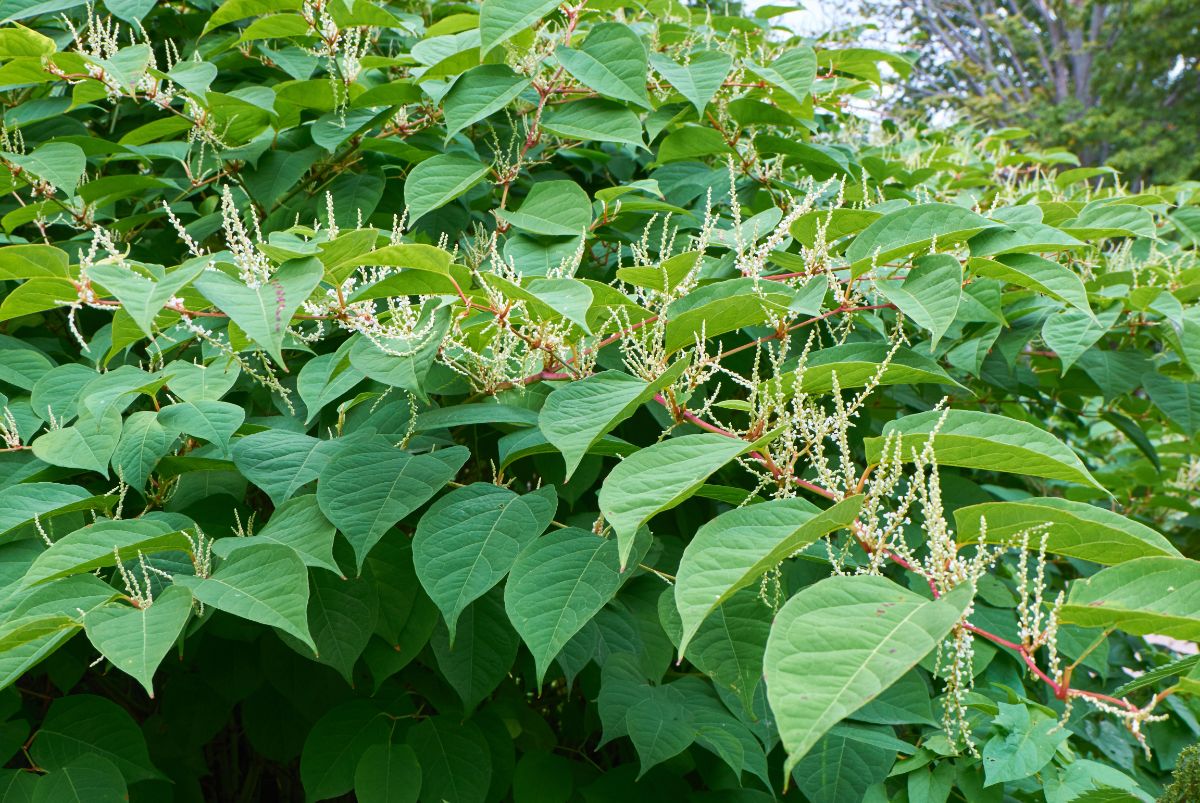
Japanese knotweed is another notorious invasive plant that is often spotted along forest edges, roadways, and other disturbed areas. Like other invasives, Japanese knotweed is extremely adaptable, and it can thrive in areas where other plants can’t. It also bounces back quickly after being cut, which is part of the reason why it is one of the first plants to colonize areas with empty earth or newly constructed buildings.
Japanese knotweed grows like a monster, and its long, knobby canes can stretch up to 10’ tall! These plants are sometimes known as Godzilla weed or Japanese bamboo because they have segmented stems that look a bit like bamboo. This plant is most noticeable in late summer when it produces large, white, foamy flower heads that are quite distinct.
One interesting thing about knotweed is that the young shoots are edible and are a favorite among foragers. Shoots can be baked, sauteed, or cooked in other ways, and they have a crunchy texture and tart flavor that is reminiscent of rhubarb. Repurposing invasive knotweed into edible food is one convenient way to put this nuisance plant to good use, but beware of how you dispose of plant parts and don't spread the seed!
3. Kudzu (Pueraria montana)
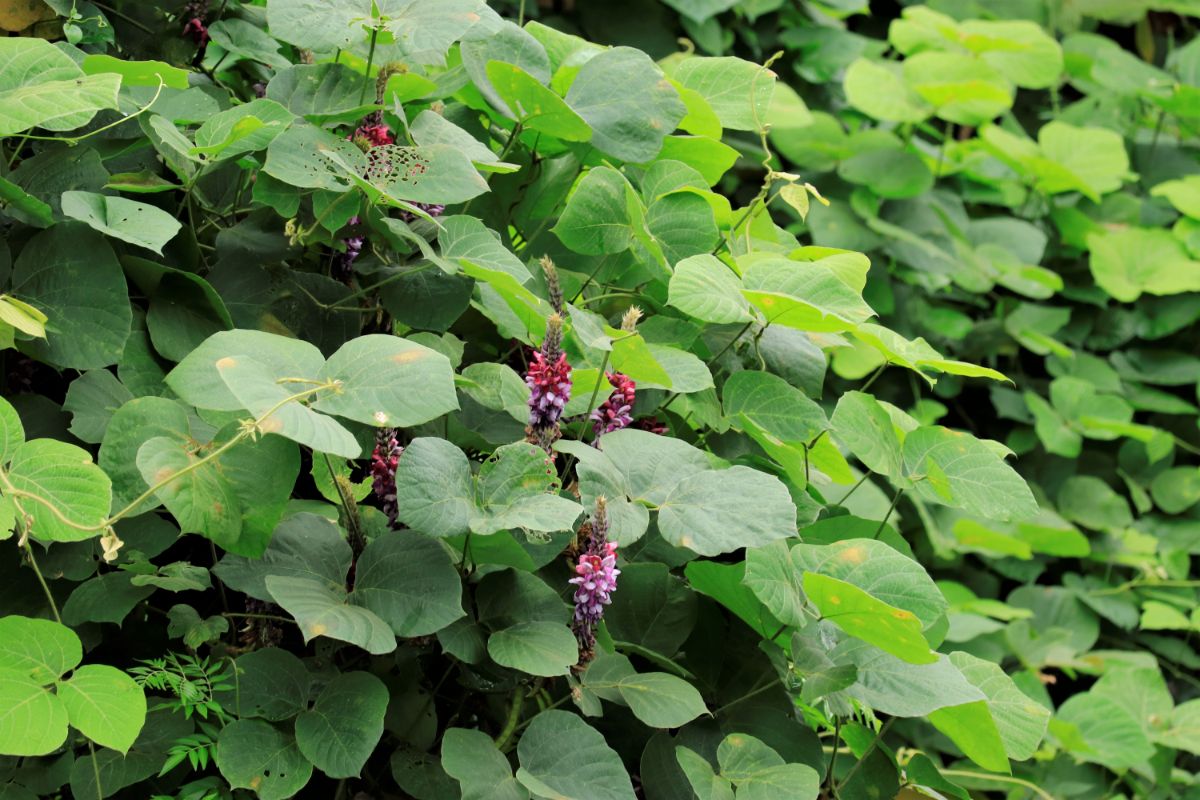
Kudzu was first introduced in America in the 1870s, and it was used as an ornamental plant and privacy screen. A few decades later, kudzu was intentionally planted throughout the southeastern United States to combat erosion, but the plant quickly escaped domesticity and has been causing problems for native plants for many years. Specifically, kudzu is well-known for its ability to choke out other vegetation, and it can climb up trees and even cause them to collapse due to the weight of kudzu vines!
Kudzu is mostly recognized by its rich, green leaves that are formed from 3 distinct leaflets. But kudzu vines also bloom from mid-summer to fall, and their colorful flowers look a bit like purple lupines. Full-grown kudzu vines can reach over 100’ long, and they can grow up to 1’ a day!
One of the best ways to get rid of kudzu is to employ livestock to do the job for you. Kudzu is often used as fodder for livestock, but goats and cows can clear infested landscapes of this troublesome plant too!
4. Barberry (Berberis spp.)
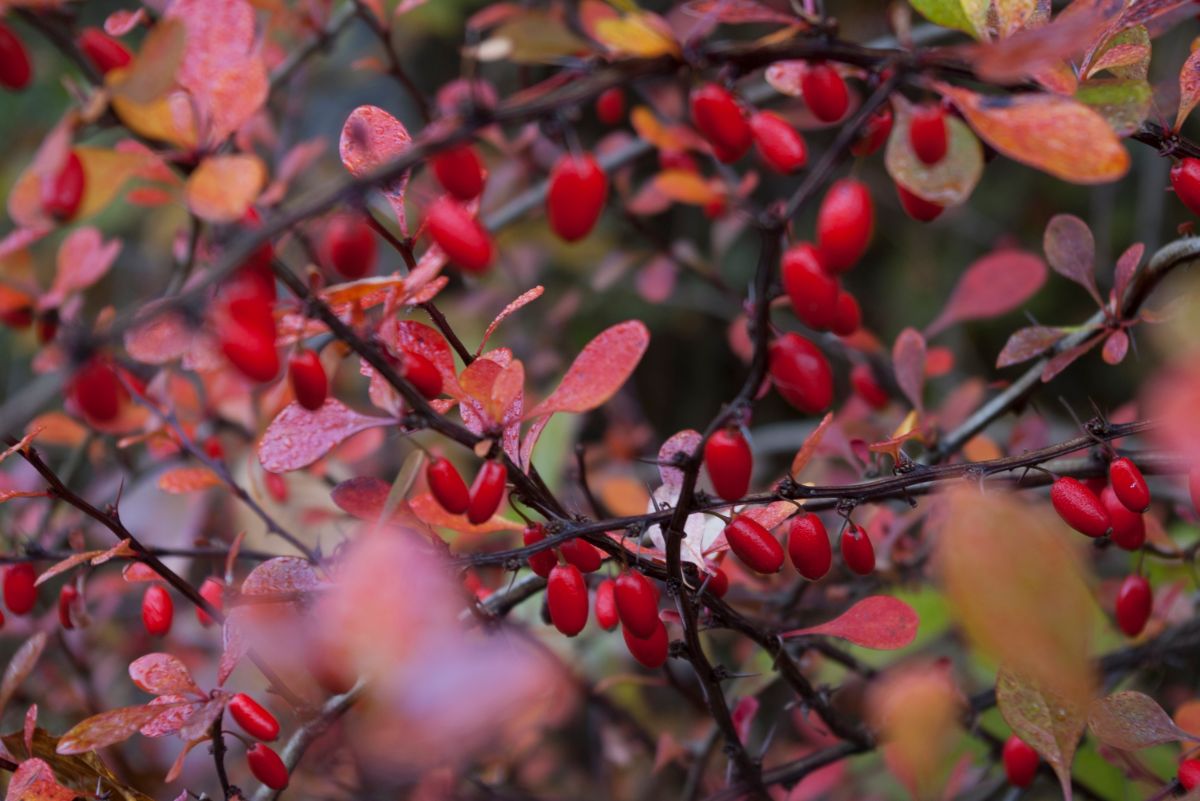
Both common barberry and Japanese barberry are invasive plants, although they are still often sold at plant nurseries and used in ornamental landscaping. The problem with these plants is that they will rapidly spread, and they can drown out native plants. Birds frequently disperse barberry seeds, but humans can also track them around in the treads of their shoes or in their tire wheels.
Another issue with barberry stems from the fact that these plants provide an ideal habitat for ticks, and they can promote the spread of Lyme disease. Part of this has to do with the fact that barberry shrubs maintain humidity levels well, which benefits ticks. Barberry also has thorny stems that make it hard to eradicate.
Barberry shrubs were first introduced towards the end of the 19th century, and they were mostly used as ornamentals. If you like the look of barberry, opt for less invasive plants in your garden or try out native plants instead. Certain hollies, ninebark, and winterberry can all serve as excellent substitutes for barberry in landscape designs.
5. English ivy (Hedera helix)
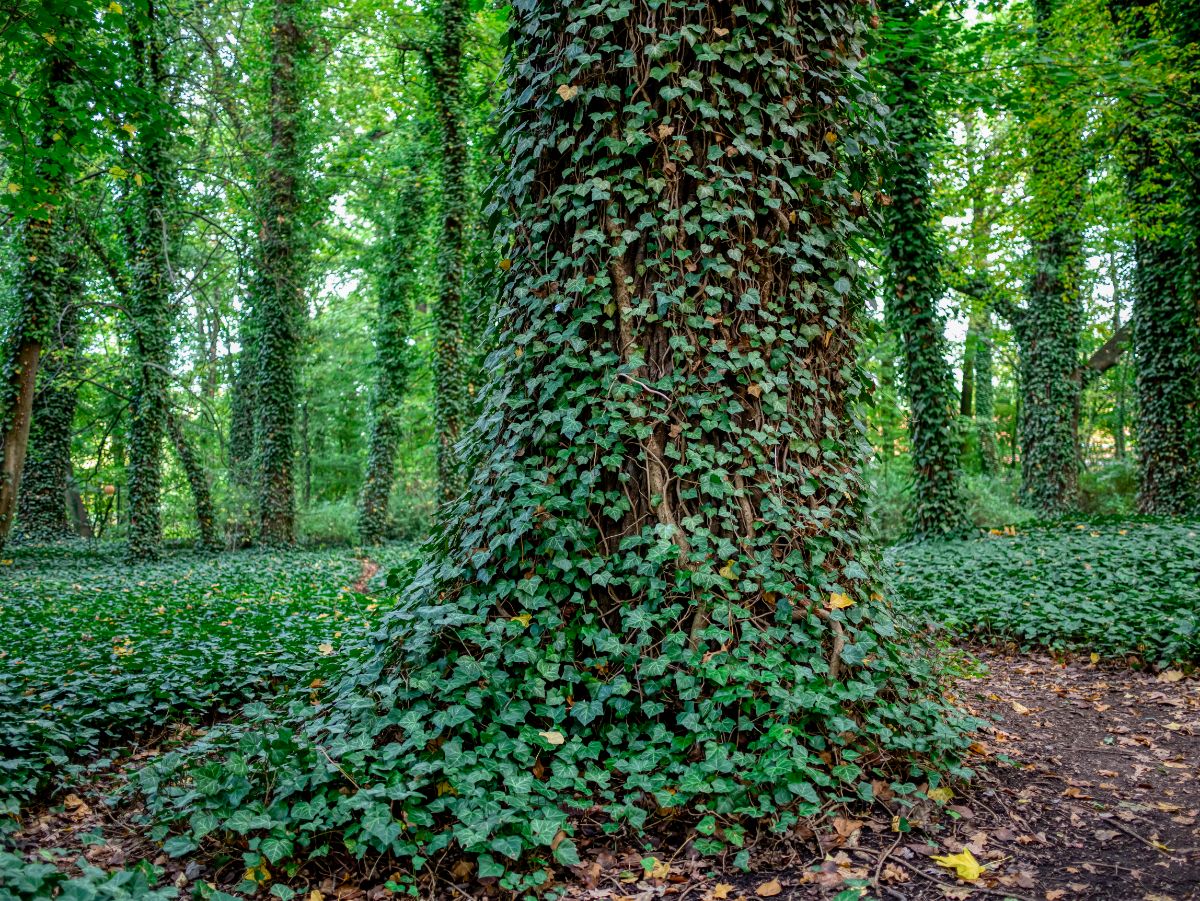
English ivy is often grown as an indoor plant, but it is also frequently used in outdoor garden designs. Unfortunately, English ivy is another invasive plant that can drown out other plants in your garden and strangle trees. English ivy vines can grow over 90’ long as well, and when they climb up trees, they add a lot of weight and can cause trees to topple over under the added strain!
Another issue with English ivy is that it has strong roots that can dig into masonry and cause foundation issues or structural problems with homes and chimneys. It is also toxic to pets, as well as livestock, but it can be removed with repeated cutting and plastic sheeting that will suffocate vines over time.
While there’s no doubt that English ivy is an attractive plant, there are lots of alternatives that you can grow that won’t cause the same problems as ivy. Climbing hydrangeas, for instance, can be used to scale garden walls, but their gentle root systems won’t damage masonry. Native plants, like mayapples, have similarly glossy leaves, and they make a nice groundcover, but they won’t cause the same problems as non-native English ivy.
6. Multiflora rose (Rosa multiflora)
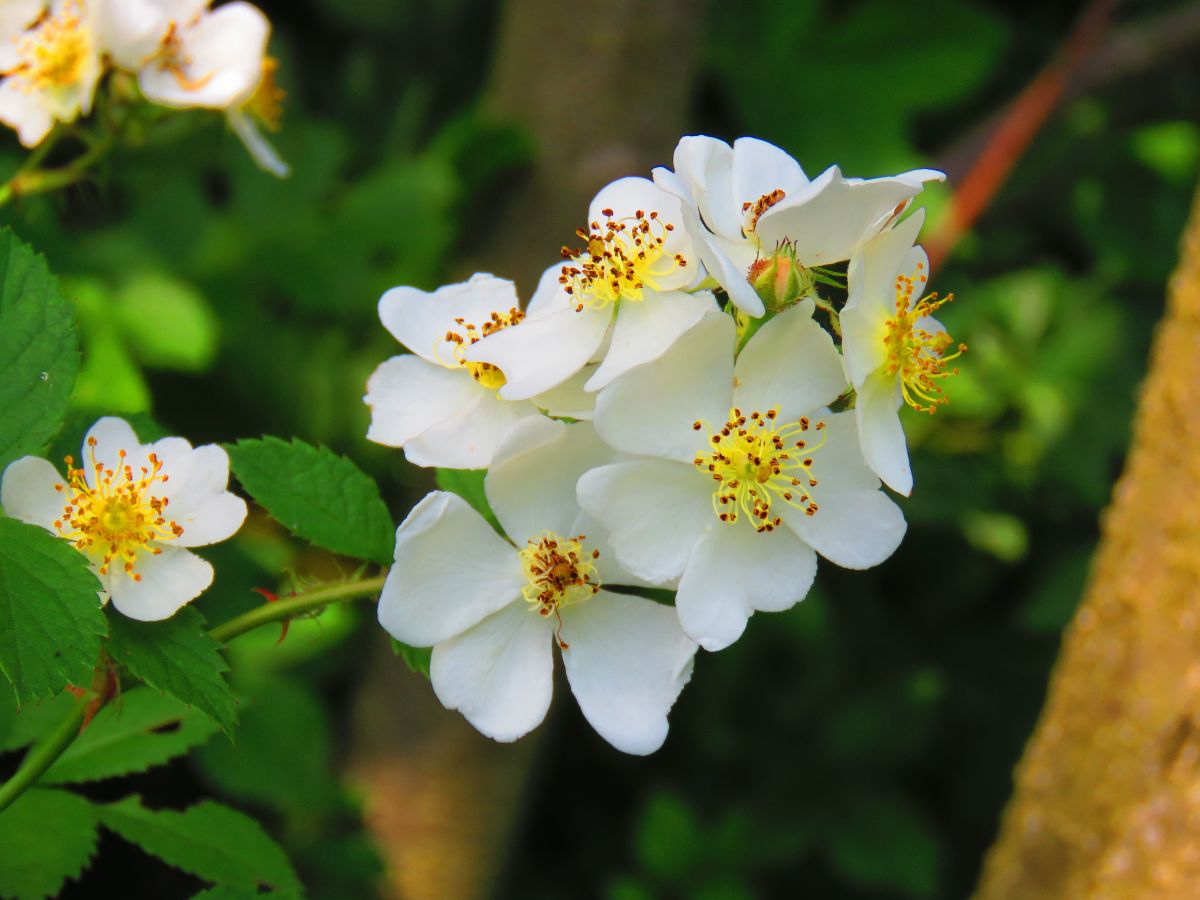
Multiflora rose is one of the prettiest invasive plants around, and it looks quite similar to other rose types. However, multiflora rose is an aggressive grower that spreads easily in the environment by its rosehips, which are full of seeds. This plant can sprout roots at each area where its stems touch the earth, making it even more difficult to eradicate!
Unlike many other rose types, multiflora rose has simple, white flower heads with five petals each. Leaves also feature a fringed stipule at the base of the leaf, which looks a bit like a centipede and can aid with identification. Many multiflora bushes grow about 6’ tall, but plants can grow to a massive height of 15’ if left unchecked, and they will choke out lower-growing plants quite rapidly too.
One of the ways multiflora rose is spread is through its edible rosehips. Often, foragers gather these rosehips and transport them to other environments, not realizing they are dealing with invasive plants! For this reason, if you forage rosehips in the wild, make sure you know what type of plant you’re harvesting from, and always gather all the rosehips carefully so that they don’t fall to the ground and sprout.
7. Japanese honeysuckle (Lonicera japonica)
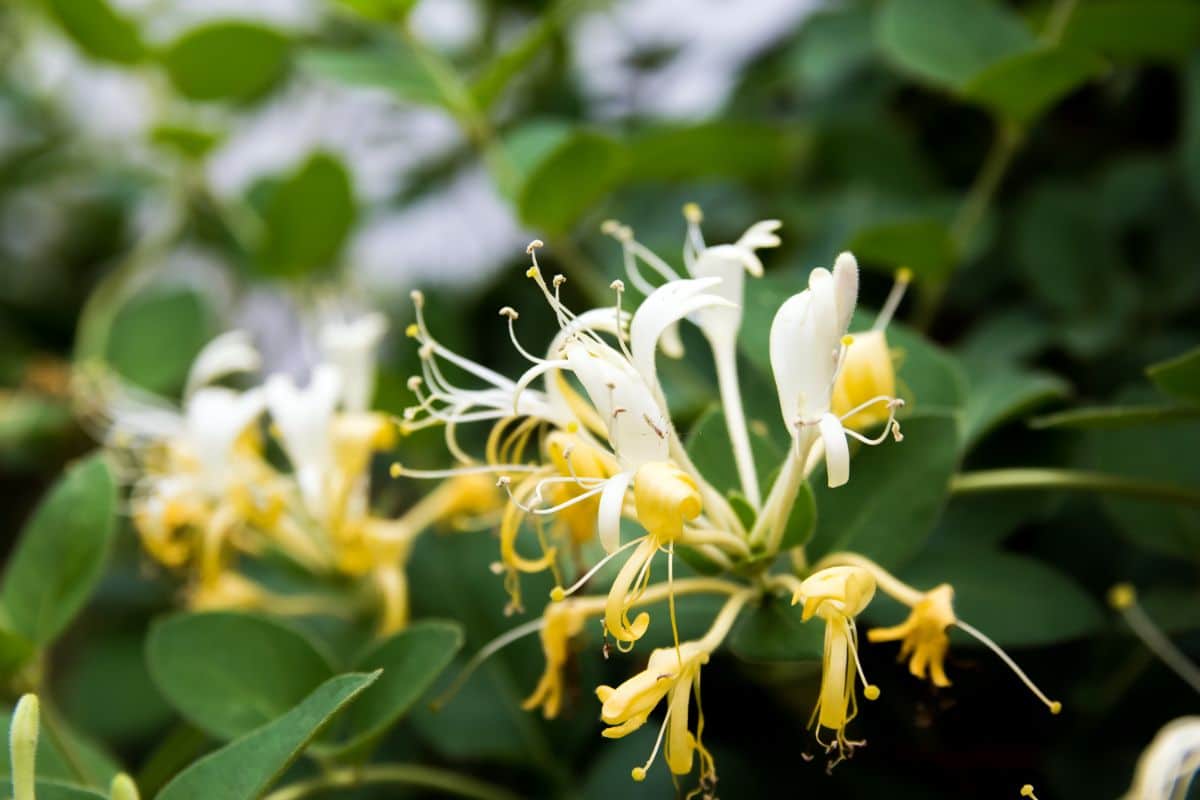
Like multiflora rose, Japanese honeysuckle is another very attractive invasive plant that was originally grown for its fragrant, yellow flowers. But, as invasives often do, Japanese honeysuckle escaped into the wild, and it can pose hazards for many plants. As with bittersweet and English ivy, this vining plant can strangle trees and cause them to collapse, and it will also block out the light from reaching other plants.
When Japanese honeysuckle arrives in an ecosystem, it can rapidly outcompete native plants and create a monoculture where few plants can thrive. This can destroy biodiversity and even affect native pollinators and other wildlife. Plus, Japanese honeysuckle produces toxic berries that can be dangerous to have in yards with pets and small children.
Although Japanese honeysuckle is a bewitching plant, there are native honeysuckles that will give a similar look to your garden. Coral honeysuckle, for example, has stunning red flowers that are rich in nectar and very attractive to pollinators, although it is not fragrant. If you like the idea of keeping a scent garden, strongly fragranced plants like peonies, phlox, and lilac can be great choices, and they won’t cause the same issues as Japanese honeysuckle.
8. Bamboo (Phyllostachys spp.)
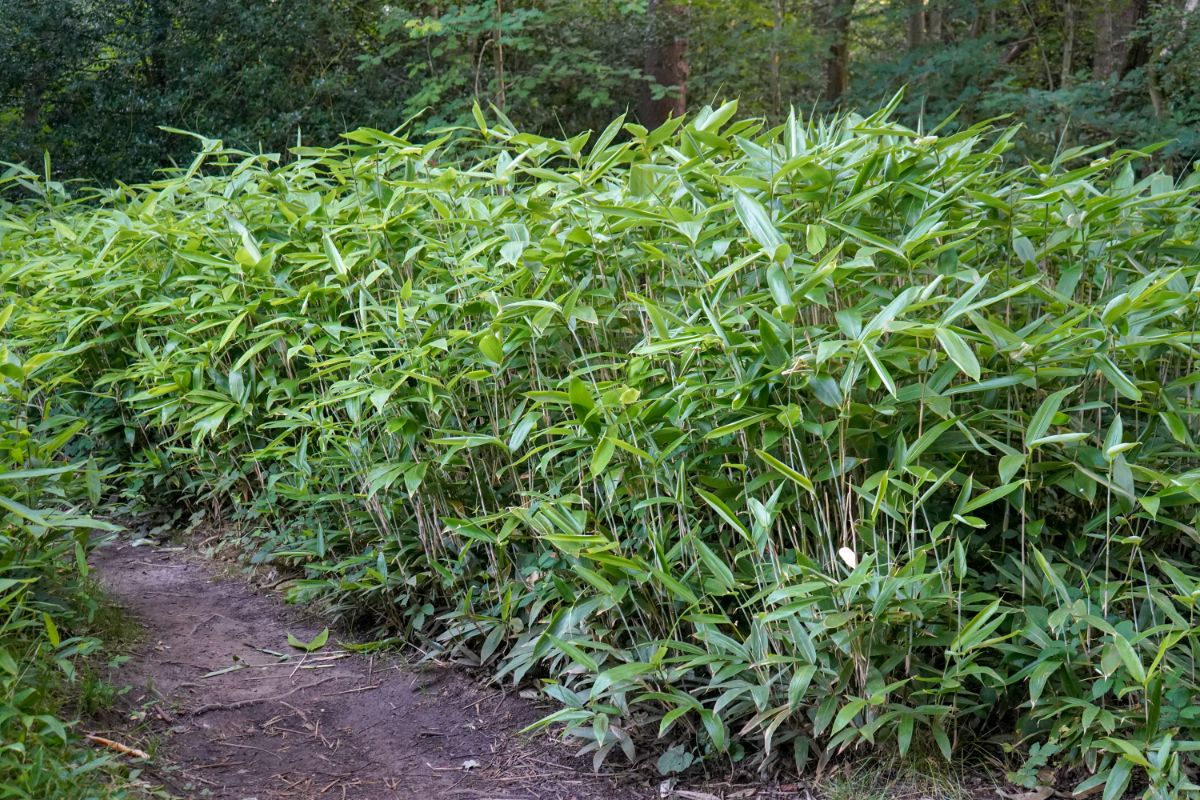
Bamboo is a common plant in many landscape designs, and not all bamboo types are invasive. Clumping bamboo, for instance, doesn’t spread vigorously, and it stays compact enough that you can even keep it in small gardens or containers. However, running bamboo is a spreading plant that does become invasive, with Golden bamboo and Yellow Groove bamboo being particularly problematic cultivars.
Bamboo spreads via underground runners, so even if you grow running bamboo in pots or container gardens, these plants can be very difficult to manage. And when bamboo escapes into the wild, it can outcompete many plants, and it can even damage masonry and foundations. Some varieties of bamboo also get massive, and they can stretch over 100’ tall!
If bamboo has invaded your garden, you can often manage it by repeatedly cutting it down to the ground and digging up as many roots as you can. Over time, this will weaken the bamboo plants, and they won’t return. But if you’re thinking about growing bamboo, make sure you select clumping varieties!
9. Norway maple (Acer platanoides)
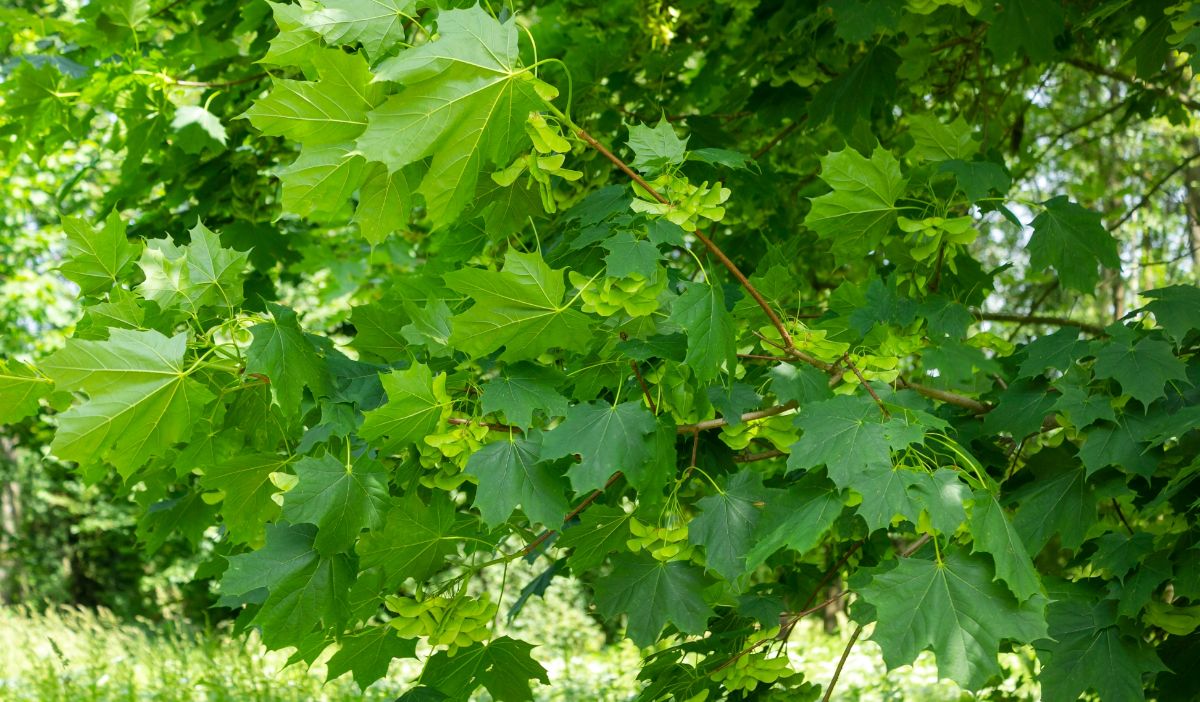
Norway maples aren’t as obvious as some other invasive species because they look a lot like native maple trees. The problem with these plants is that they are more shade tolerant than many other maple varieties, and they are able to thrive in areas that many native maples can’t. This gives Norway maples an advantage over native maples, and it can allow them to outcompete species like sugar maples, which is the variety of maple most often used to create maple syrup.
Norway maples are from Europe, and they were introduced to the United States as ornamental plants due to their shade tolerance. But Norway maples cast a lot of shade, and they can stifle the plants that grow beneath them. Norway maples also have escaped into the wild, and they readily seed themselves by their winged seeds that catch on the wind.
While it can be difficult to ID Norway maples, these plants tend to leaf out earlier in the season than native maple trees. But one of the best ways to determine if you’re dealing with a Norway maple is to snap its petiole (the leaf stem) in two. If the petiole exudes a milky sap, it’s a Norway maple.
10. Burning bush (Euonymus alatus)
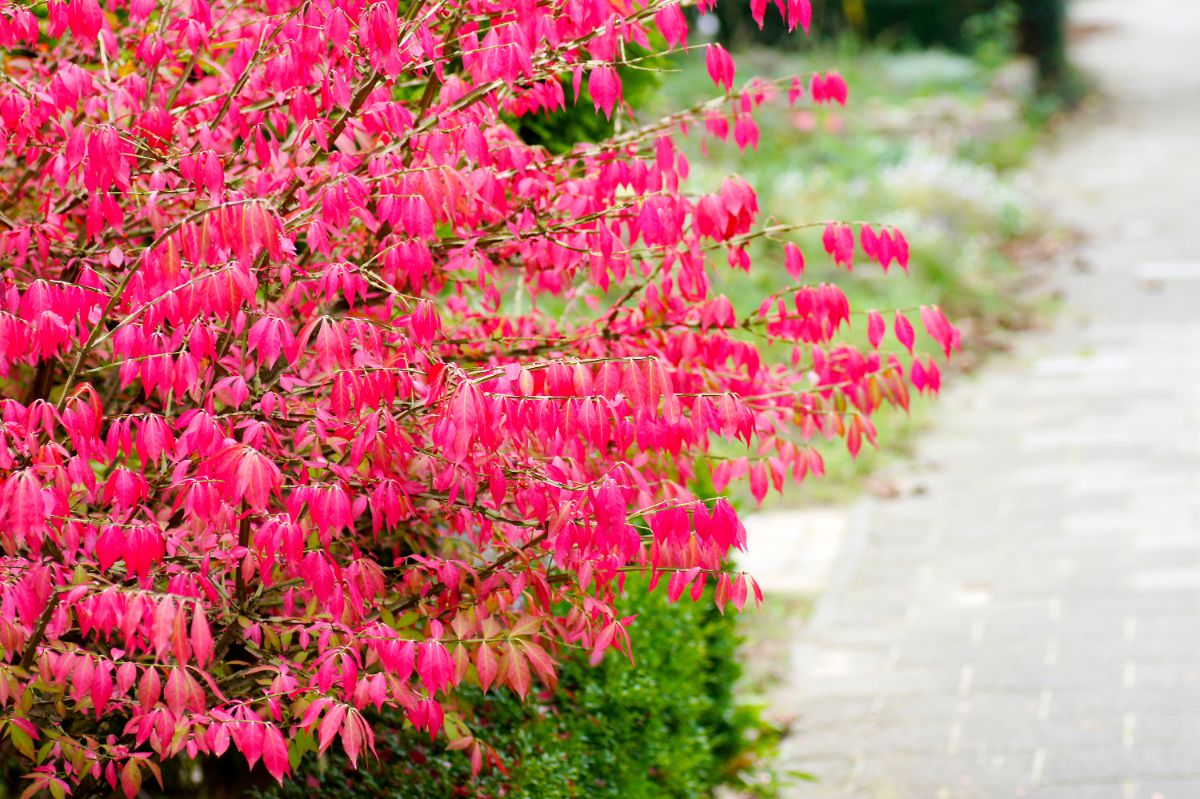
Burning bush is native to Asia, and it was introduced into America as an ornamental shrub in the 1860s. This plant is mostly known for its low maintenance needs and its fiery color when its leaves change into a bright, pure red in autumn. Burning bush is still available for sale at many plant nurseries, but it is classed as invasive in many areas, and it is even banned in certain parts of America.
Burning bush spreads rapidly by seeds that are often dispersed by birds and other wildlife. Like many other invasives, this plant creates a dense thicket that makes it difficult for other plants to grow, and it will outcompete many native plants. Repeated cutting and mowing can keep these plants in check, and you can also add plastic sheeting over areas where you removed burning bushes to keep seeds from sprouting.
If you want bright autumn color but don’t want to grow invasive burning bushes, try out red maples, which don’t spread as vigorously but offer the same bright color. Or try out native plants like winterberry holly, American strawberry bush, ninebark, and certain dogwoods that also provide lots of seasonal colors.
11. Garlic mustard (Alliaria petiolata)
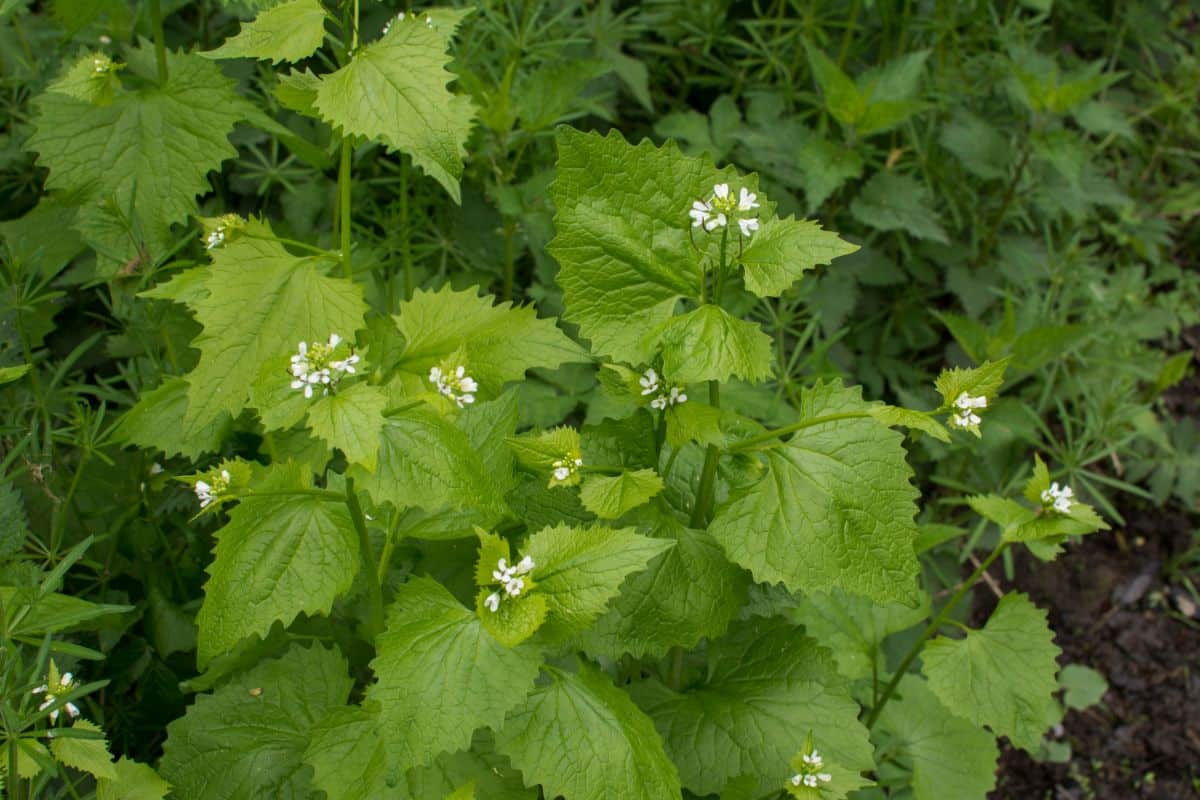
Garlic mustard was introduced into the United States in the mid-1800s, and it was initially used as a medicinal plant and herb, but it also showed promise for controlling erosion. Unfortunately, this vigorous grower also began to cause problems for native plants when it started to spread into the environment. Today, you can easily find large patches of garlic mustard almost anywhere, but they are especially common along roadways and other exposed areas.
Garlic mustard is named for the strong garlic smell that its leaves produce when crushed, and young plants are edible, but older plants should be cooked before eating as they contain cyanide. As with Japanese knotweed, finding ways to use garlic mustard in recipes is a great way to put troublesome invasive plants to use. It also encourages foragers to gather more of this plant from the wild to keep it from growing!
As with other invasives, garlic mustard spreads rapidly, and it will keep native plants from growing. Part of this is due to the fact that garlic mustard grows earlier in the season than native plants, and its taller growth can block the light from reaching newly sprouted natives. Garlic mustard also releases chemicals into the soil that inhibit the growth of other plants, including trees, and this can change the look of landscapes over time.
12. Wintercreeper (Euonymus fortunei)
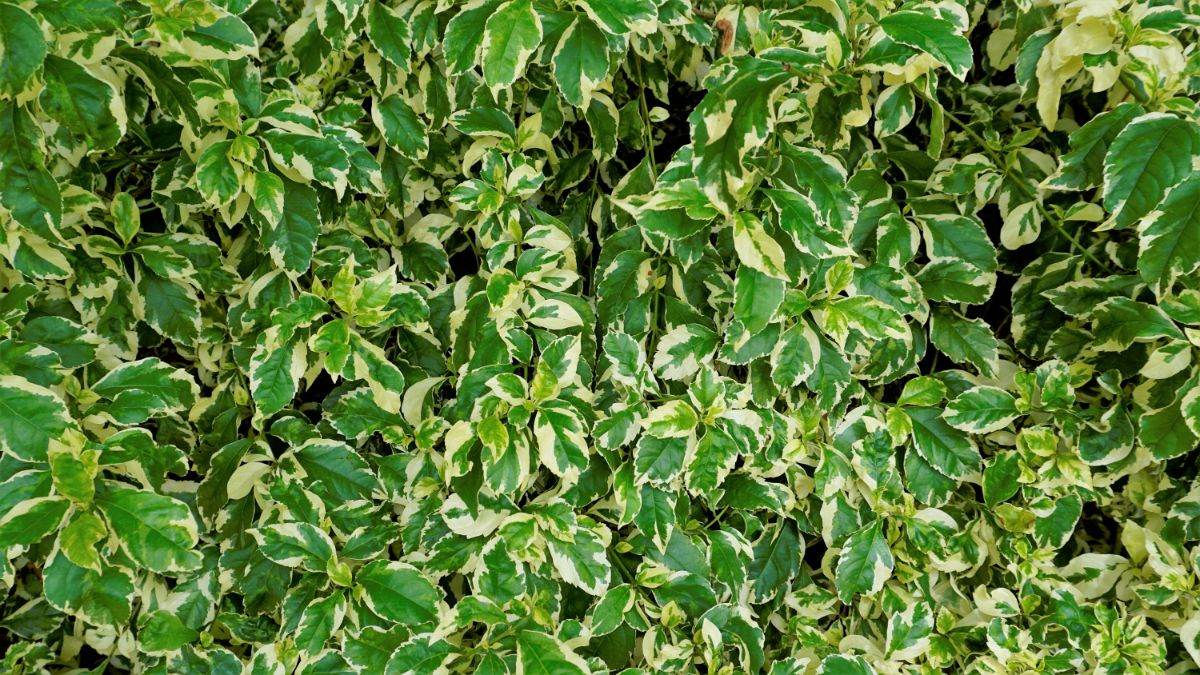
Wintercreeper was brought to the United States as an ornamental, and its evergreen leaves made it the perfect groundcover. Unfortunately, this plant has become invasive in many states, and it is especially troublesome because it grows low along the ground and can displace a wide variety of native plants. Wintercreeper can also crawl up trees and block the light from reaching their leaves, which eventually kills them.
Wintercreeper spreads by stems and roots, but it is also easily dispersed by birds that devour the plants seeds. Many other invasive plants spread in this manner, which is why it’s a good idea to keep garden beds mulched. Mulches, like wood bark and pine needles, can keep the soil covered and make it much more difficult for invasive plant seeds to sprout.
You can still find wintercreeper for sale at plant nurseries, but it’s best to avoid it. If you want an evergreen ground cover, American wintergreen is a native plant that has similarly glossy green leaves, but it also produces pretty red berries. Bearberry, wild ginger, and American strawberry bush are other good alternatives to wintercreeper, and they’re native plants too!
Removing invasive plants without chemicals
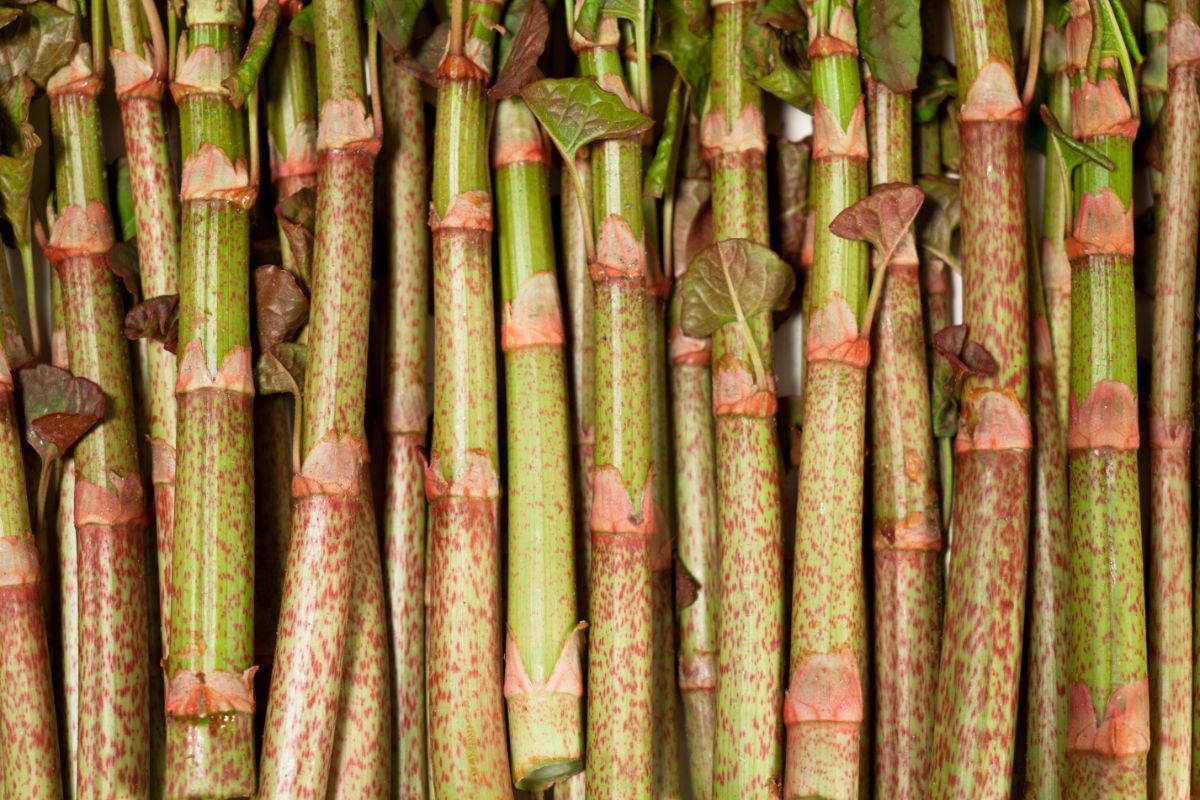
If invasive plants have found their way into your garden, you will want to tackle them as soon as you can, but there’s no reason to reach for chemical herbicides.
Many invasive plants can be controlled organically by cutting or mowing them several times throughout the growing season. This process keeps invasives from setting seeds, and it also slowly weakens the plants so they don’t regrow.
Mowing and cutting can also be combined with digging invasive plant roots and smothering plants with black plastic. After removing as much of the plant as you can, you can cover the area with black plastic sheeting to deprive the plants’ root systems of light, water, and nutrients. Or you use clear plastic sheeting to solarize your soil, essentially baking invasive plant roots in the summer heat.
Weeding torches and horticultural vinegar can also kill many invasive plants and keep them from coming back. You may also be able to “rent goats” or other livestock to tackle invasive plants for you!
No matter which method you choose to control invasive plants, it’s important to be consistent. Over time, you can eradicate even the toughest invasive plants and make your garden more hospitable for native plants and other ornamentals you’d like to keep.
Summary
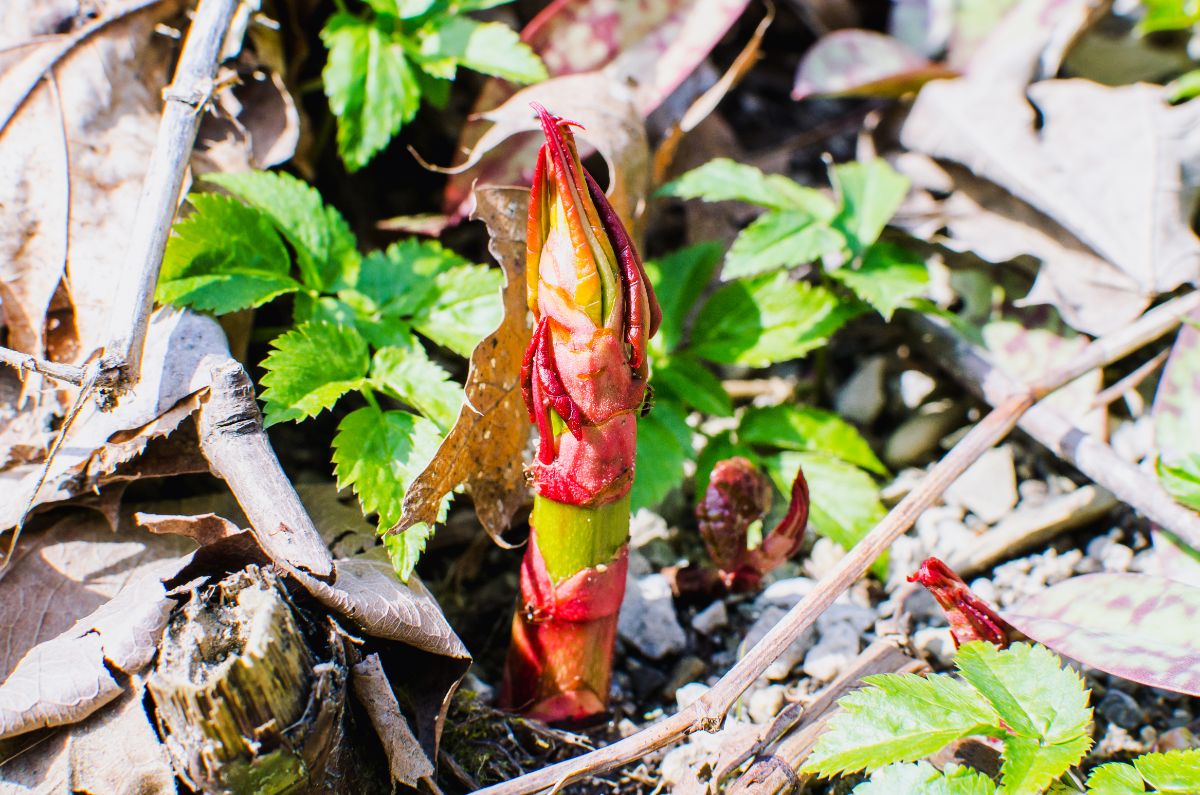
Invasive plants can cause a lot of issues in gardens and the environment as a whole. They can reduce biodiversity, change habitats and cause other issues too. But there is hope.
Being able to properly identify invasives is the first step in combating them. After that, removing invasive plants may require some elbow grease and a bit of work, but the results are worth it. Once invasives are long gone, and you have your garden back as you like it, you’ll have plenty of space to grow native plants and other charming ornamentals too.
While invasive plants can be a pain, some of them are quite tasty! If you’d like to learn more about how to use edible invasives, like Japanese knotweed, you discover tips on foraging for wild weeds right here.

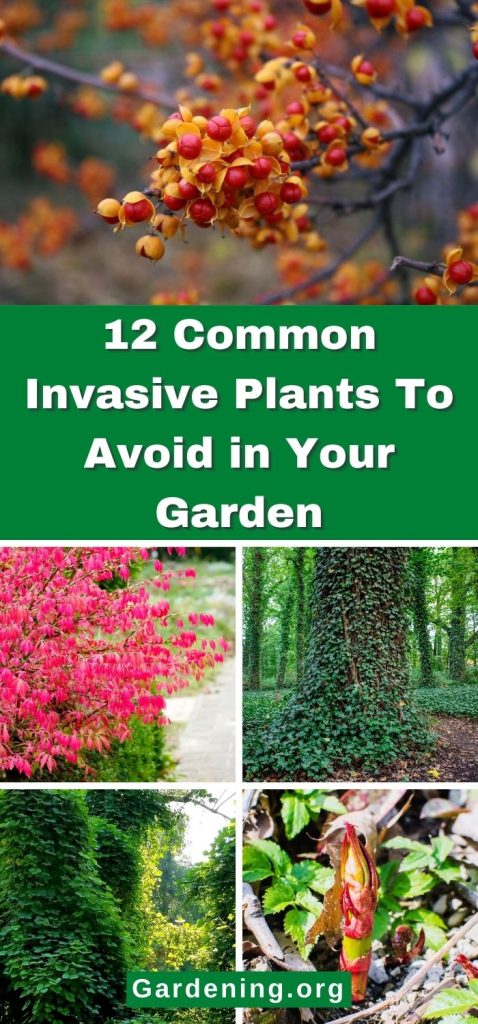
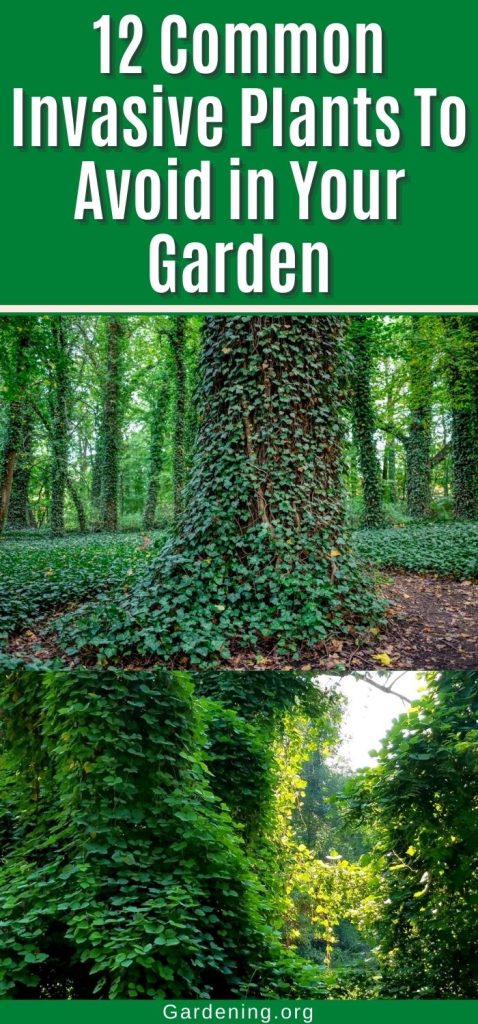
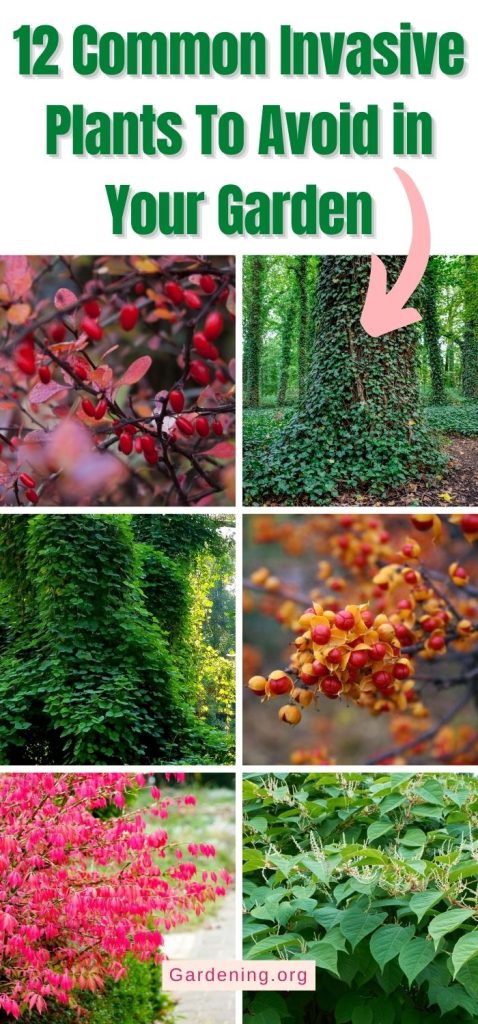


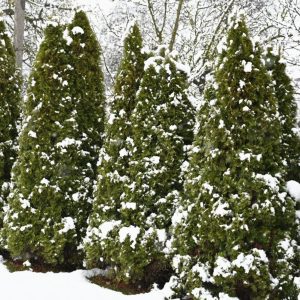


Jacqueline D'Amboise
Great article. You forgot Jerusalem artichoke. I am still trying to eradicate it as it takes over the land around it. The word you want is hospitable...not hospital.
Mary Ward
Yes there are others for sure that could be on this list. Jerusalem artichoke is a useful plant and can be controlled over time with consistent mowing and digging. Certainly it has proven problematic for some people, though, and opinions differ.
Apologies for the typo; it's been corrected. At least you know real humans wrote this article! 😉
A coulling
Never had a problem with Jerusalem artichoke and had a small patch for years.
Mary Ward
It is capable of spreading rapidly, but it's generally able to be controlled by mowing the shoots and other methods. It is smart to keep it in a dedicated patch. It is not something I would personally include on this list because it is more useful and more controllable than things like bittersweet. It's been the subject of studies for the past few years because it has some excellent uses, including things like insulin production, soil reclamation for saline soils, biofuels, pectin, edible food, and more. They're great for pollinators and wildlife. And they are a native to much of the US and Canada. An argument could be made that they are invasive to some areas, but I'm not convinced they belong on this list. Of course, that could depend on where you live, too. All of these plants are native to somewhere and in their natural environment, they're not typically considered invasive. Experts don't seem very decided on it being invasive, either...just pervasive. It's kind of one that depends on your goals and your tolerance for it. https://ask2.extension.org/kb/faq.php?id=796441
https://www.wildflower.org/plants/result.php?id_plant=HETU
https://www.mdpi.com/2073-4395/12/2/465
https://www.ncbi.nlm.nih.gov/pmc/articles/PMC5466194/
https://www.sciencedirect.com/science/article/abs/pii/S0929139321002018
Nikki Wharton-Eby
Very interesting article! I found the presence of Burning Bush a real surprise to have on a list of "bad plants" for a garden or yard. I have not had any problems with mine --- other than losing two of them in the first three years of their planting. I have three remaining, far from each other in my yard.
What about trillium? It appears to be a native plant in some forests and wooded parks.
Mary Ward
I know what you mean about the burning bush. It's something I've seen added to invasive lists over the last several years. I think it surprises a lot of us and a lot of people may not have had much if any issue with it. As with all of these, there could be a big difference depending on where you live. It might be worth checking your own state's or country's list.
As far as I can tell, trillium, while a good spreader, is not considered an issue.